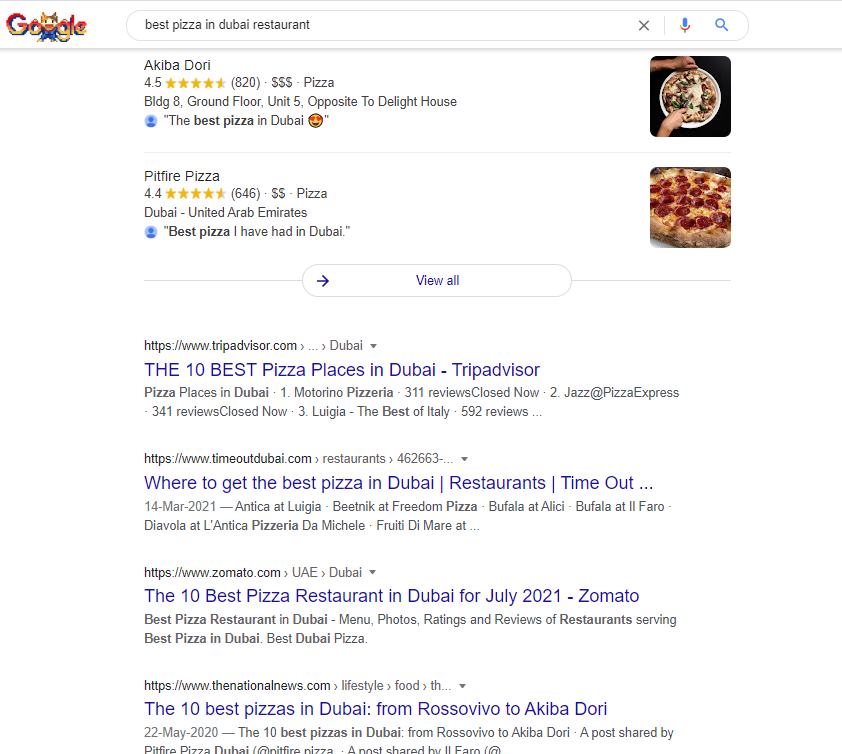Nothing excites us more than being able to see new restaurant startups thrive in terms of scalability. Aside from marketing, scalability comes as a result of restaurant website SEO for F&B businesses. Now, we know that a lot of establishments believe that they have nailed down the practices to implement SEO and know what to do, but a lot of things have changed over the past couple of years.
So, what we’re looking at right now, in terms of restaurant website SEO, isn’t just the basic tips to cover the lay of the land. Right now, SEO for any online and offline business is about adapting to modern practices and doing something different than your competitors.
This post highlights some of the most effective tips for food business startups looking to set a foothold on the internet through search engine optimization. In addition, we have made a few recommendations along the side to help you understand the significance of a given strategy, and why you should be implementing it in the first place.
What is Restaurant Website SEO?
So, you have your restaurant website ready with a couple of pages that are indexed by Google.
Since, we are way past the 10-year timeline where Google’s Panda, Penguin, Humming Bird, and such other algorithms pertinent to SERPs have already rolled out, it doesn’t take a genius to figure out that SEO stands for Search Engine Optimization.
The question is, beyond the abbreviation, what exactly does restaurant website SEO represent?
The put it simply, it is a practice that involves certain on-page and off-page “optimizations” to help your restaurant business with better visibility when someone types down your restaurant name, or a bunch of common keywords in the Google search bar.
Ideally, your restaurant’s name or services should be within the first 10 results on the first page of Google search. If it goes on to page two, it’s not that bad because the competition might be high and other F&B businesses around you are probably paying for high-volume keywords that are bringing traffic to their respective online restaurant website pages.
Regardless, the ideology behind restaurant website SEO, or SEO for any popular online business is to get more “relevant” traffic and have higher conversions that can turn into repeat customers over time.
An Example of Keyword(s) from Restaurant SEO Perspective:
Let’s say, you have a fancy brand-new restaurant established in Dubai or Abu Dhabi. Your main specialty is the region’s cultural dishes, or perhaps a unique pizza that none other are selling on the block.
Therefore, if your potential online food order customers were to type down: “Best pizza+name in Dubai restaurant”, or perhaps, “Best XYZ+Dish+Name Abu Dhabi Restaurant”, that person should be able to see your restaurant’s website on the first page of Google AE. That way, this particular person can visit your website to place an order, and, of course, bring in more referrals who were looking for such similar food options within Dubai.
Also Read: Advanced SEO for Food Bloggers Exclusive Interview | SEMRush
Make sense?
Good.
Now, let’s take a dive into some of the best restaurant website SEO tips for your food business.
1. Focus on Keywords, the Right Way for Your Online Restaurant Business
Keywords are those words that people enter in Google, or any other search engine of their choice, to see their preferred results.
That being said, if you have a restaurant business in the Middle East, then you are basically looking at restaurant website SEO from Google’s Middle East perspective. That means that the results will be different when a person enters the same queries in Google USA because you have optimized your restaurant website for a specific audience that caters to people in a specific region.
There are a bunch of keyword classifications that you need to know about:
- Long-Tail Keywords: These keywords are longer, as in they have more word combinations and have slightly lower monthly search volume as per Google keyword statistics.
A lower search volume for long-tail keywords comes with high chances of ranking your restaurant website at the cost of a slightly low percentage of online visitors.
- Short-Tail Keywords: These keywords are short. They are usually two words; they are extremely common and it is much more difficult to rank a brand new website against them.
Short-tail keywords in any business have massive search volume, but the competition factor is equally high. Many high profile food businesses run paid keyword campaigns for short-tail keywords to rank against them. This is a common practice that’s been going on for a long time now.
If you own a food business startup, we recommend optimizing your restaurant website against long-tail keywords. Once you have accrued enough business volume, you can start to run and monitor the Google AdWords campaign for short-tail keywords that are relatively more competitive.
- Region Specific Keywords: Any keyword with the name of your restaurant and the region it is operating in. We already highlighted this with the help of a few examples earlier where user intends to find a pizza parlor in Dubai/ Abu Dhabi and enters relevant keywords in the search engine bar.
While you are picking up low competition keywords for your region, make sure that you are actually using those keywords in your restaurant website’s homepage, other main pages and vice versa. A common example is to include keywords in the title tag and sub-title tag.
Make sure that you are not spamming keywords by overusing them throughout your online restaurant website. This strategy may have worked a few years ago, but Google has become smart and the algorithm does not like spammy websites with repetitive keywords all over their internal pages.
2. Restaurant Title, Meta Description, and URL:
Your restaurant website SEO results are made up of page URLs, Titles, and the meta description.
Since it is a common practice, make sure that you are incorporating the keyword in the title, followed by what you are offering.
Likewise, the URL should be short and consist of search intent keywords that are similar to what a normal online visitor would enter. This way, you are eliminating generic words and using only those words that are relevant to your search engine optimization strategy for any given page of your website.
Lastly, meta text is a short description of that page in one or two sentences. These descriptions should have your restaurants’ main keyword and meaningful sentences that highlight the significance of your services.
If your restaurant’s expertise is homemade food in Dubai. Then your meta description for a given page should ideally include the exact same keywords, alongside a combination of well-thought-out sentences that will assist Google in establishing a correlation between the meta description and your keyword.
Do not use your phone number, address, or random word strings in the meta description. Apply the same practice for your URLs, but keep them short and precise to maximize your customer’s intent to results ratio.
3. SSL Certificate:
Ever seen that lock icon beside a website URL?
If you hover your mouse over it, the highlighted description says that this website is safe to browse, and protected by XX security.
Google encourages websites with security certificates installed on them. These certificates ensure that online transactions made to a restaurant through its online food ordering page, are secure. Also, security certificates, such as SSL, increase the prestige and trustworthiness of a restaurant website.
Search engine robots take SSL and such other certificates into account when suggesting results.
4. Getting High-Quality Links from Websites Relevant to Your Online Business:
Technically, these links are called: ‘Backlinks’, and the process is called backlinking or linkbuilding.
For restaurant website SEO purposes, backlinks should be obtained from relevant niche websites in the industry. In your case, getting links to your website’s homepage, or any other particular pages from food authority blogs, food business websites and such other web properties ensures the relevancy of your business.
For instance, if a lot of food blogging websites, and food-related platforms are linking to your restaurant’s website, it tells Google that your business is relevant to the food industry. As a result, the actual value and weightage for your website is increased.
The more quality backlinks you have from popular websites in your niche, the higher the chances are for ranking in the search engine results pages.
While you are at it, do not make the mistake of getting backlinks from irrelevant websites. If your restaurant homepage is getting backlinks from an Auto Blog, or a Pets business, you are looking to decrease your business’s relevancy.
The point is, relevant links from the same niche are like endorsements that Google takes into account when “referring” people to your online restaurant website.
5. Is Your Restaurant Website Mobile-Friendly?
We are not just talking about a visually appealing page that opens up on mobiles.
Since 80% of the world’s population uses cellphones to visit all kinds of websites these days, “mobile-friendliness” interprets into the following aspects for your restaurant:
- Efficient mobile food ordering system
- Fast processing mobile pages with minimum load times
- CTAs on the mobile websites that improve conversions for food orders
- Well placed links, checkboxes, other relevant material on the mobile theme for your restaurant
- An overall easy food ordering process for people coming to your website through mobile phones
The bottom line is that mobile-friendly pages – and that too, with AMP (*Google Accelerated Mobile Pages) has become a high factor in overall restaurant website SEO strategies. Your website will rank well and bring in a significant amount of online users who will repeatedly order food through their cellphones.
On that note, the mobile pages have to be responsive and well optimized so that everything is displayed within the viewing area of different mobile device screens.
What’s the Easiest Way to Implement Restaurant Website SEO Tips?
We don’t expect you to labor through all the restaurant website seo implementations on your own.
Get hired help, if you can.
The only downside to hiring professional SEO firms is the exorbitant amount of expense that you need to deal with. High-quality SEO strategies take time and patience to show results.
Our best advice is to get in touch with Blink Co. Especially if you are a brand-new food startup business owner, you are already strapped for cash. What Blink does is that it signs restaurant businesses up for a monthly subscription plan where everything is taken care of on one platform.
Restaurant owners get a bunch of bleeding-edge tools and a dedicated white-labeled space that comes with the following perks:
- Efficient online restaurant menu creator
- White-labeled mobile and desktop websites for your restaurant
- Visually optimized pages with CTAs that improve conversions
- Customer data analytics dashboard to market your restaurant services
- Pos module integration with flexible payment options for online food ordering customers
Above all, Blink Co. has a robust hyper-active customer support team. If you are ever stuck on something that’s preventing your online restaurant to operate at full speed, the customer support team is always there to get you out of the pickle.
For more details, or to book a demo, visit Blink for Restaurants Page today.
Related Articles:
 The Ultimate Guide on Starting your Own Food Truck Business
The Ultimate Guide on Starting your Own Food Truck Business
 Restaurant Social Media Marketing; 5 Best Strategies For New Businesses
Restaurant Social Media Marketing; 5 Best Strategies For New Businesses
 Restaurant Guide: How To Convert Third Party Customers To Direct Ordering?
Restaurant Guide: How To Convert Third Party Customers To Direct Ordering?
 5 Important Restaurant App Features You Need To Scale Your Food Business
5 Important Restaurant App Features You Need To Scale Your Food Business
 Top 8 Italian Restaurants In the UAE
Top 8 Italian Restaurants In the UAE







